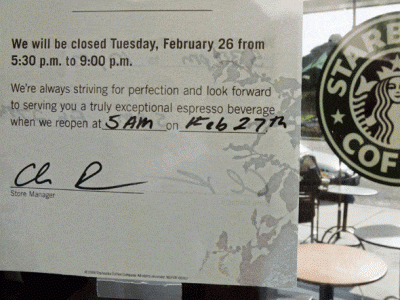by Shane Hildreth – May 2013
Think back to your childhood.
You’re playing with your friends in the front yard and a four letter word comes flying out of your mouth just as your mom walks outside. And just like that, you’re grounded.
You knew you shouldn’t have said it, but it’s just a word…What’s the big deal?
Well, when it comes to servicing corporate partners, “NO” is a four letter word. You should treat this word as the worst four letter word you can think of. Think of your corporate partner as your mother.
Dealing with the impossible
Suppose a client asks you to run across the field during the middle of a game waving the company banner. Your initial answer should be, “Wow, that would be awesome, wouldn’t it? Let me check with our marketing department and see what we can do.”
Go to your team to discuss what the client would like to achieve and come up with alternatives. Your client probably understands the original request is unlikely and will appreciate you presenting viable options.
 The role of partner services is to activate the contract in a positive and timely manner. Putting up road blocks potentially harms the overall relationship. Direct the conversation away from what you can’t do. Focus on what you can do. Turn the conversation from negative to positive.
The role of partner services is to activate the contract in a positive and timely manner. Putting up road blocks potentially harms the overall relationship. Direct the conversation away from what you can’t do. Focus on what you can do. Turn the conversation from negative to positive.
How to say, “Yes I no.”
Every good sales person needs an alternative to the word “no” to signal you are considering the client’s concerns.
- “Let me check with my boss.”
- “Let me check with our marketing department.”
- “Let me check with our league office.”
- “I’ll need to see if that piece of inventory is available.”
- “Due to another contract we might be limited in what we can do.”
These examples buy time to come up with options to help clients achieve their marketing goals.
[dropshadowbox align=”center” effect=”lifted-both” width=”550px” height=”” background_color=”#ffffff” border_width=”1″ border_color=”#dddddd” ] “Our success with athletic sponsorships is tied directly to the relationships we have with our sports representatives. We view them as an extension of our team.
“Our success with athletic sponsorships is tied directly to the relationships we have with our sports representatives. We view them as an extension of our team.
My job is not merely to say “Yes” and “No” to prospective projects, but to ask, “How can this partnership be mutually beneficial?”
A good sports representative understands that and pitches projects accordingly. When we work with someone we trust and believe is truly there to help our company succeed, the possibilities for collaboration are endless.”
Brianne Bruner, Regional Sales and Marketing Manager, Wells Fargo Bank Houston[/dropshadowbox]
Fight for your client
[dropshadowbox align=”right” effect=”lifted-both” width=”250px” height=”” background_color=”#ffffff” border_width=”1″ border_color=”#dddddd” ]

When presenting an idea to a sponsor saying, “ I understand your goals you are trying to achieve, here is another solution we have seen done before that has been successful,” you add value to the partnership.[/dropshadowbox]When you know that there is no way a particular request could ever happen, you still need to show you are fighting for your client’s best interest.
If you tell your client no immediately, it means that you are not fighting for them.
At the end of the day you should be fighting for your clients to get them everything they need to make the partnership mutually beneficial. You are the internal negotiator for them with your team. You work for them just as much as you work for your property.



















